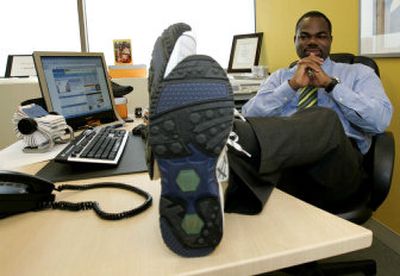GPS-enabled shoes should be easy to find

MIAMI – Isaac Daniel calls the tiny Global Positioning System chip he’s embedded into a line of sneakers “peace of mind.”
He wishes his 8-year-old son had been wearing them when Daniel got a call from the boy’s school in 2002 saying his son was missing. The worried father hopped a flight to Atlanta from New York, where he had been on business, to find the incident had been a miscommunication and his son was safe.
Days later, the engineer started working on a prototype of Quantum Satellite Technology, a line of $325 to $350 adult sneakers that should hit shelves next month. It promises to locate the wearer anywhere in the world with the press of a button. A children’s line will be out this summer.
“We call it a second eye watching over you,” Daniel said.
It’s the latest implementation of satellite-based navigation into everyday life – technology that can be found in everything from cell phones that help keep kids away from sexual predators, to fitness watches that track heart rate and distance. Shoes are harder to lose than phones, watches and bracelets.
The sneakers work when the wearer presses a button on the shoe to activate the GPS. A wireless alert detailing the location is sent to a 24-hour monitoring service that costs an additional $19.95 a month.
In some emergencies – such as lost child or Alzheimer’s patient – a parent, spouse or guardian can call the monitoring service, and operators can activate the GPS remotely and alert authorities if the caller can provide the correct password.
Once the button is pressed, the shoe will transmit information until the battery runs out.
While other GPS gadgets often yield spotty results, Daniel says his company has spent millions of dollars and nearly two years of research to guarantee accuracy. The shoe’s 2-inch-by-3-inch chip is tucked into the bottom of the shoe.
Experts say GPS accuracy often depends on how many satellites the system can tap into. Daniel’s shoe and most GPS devices on the market rely on four.
The company also has put the technology into military boots and is in talks with Colombia and Ecuador, Daniels said.
But retail experts say the shoe might be a tough sale to brand-conscious kids.
“If (parents) can get their kids to wear them, then certainly there is a marketplace. But I think the biggest challenge is overcoming … the cool marketplace,” said Lee Diercks, managing director of New Jersey-based Clear Thinking Group, an advisory firm for retailers.
The GPS sneakers, available in six designs, resemble most other running shoes. The two silver buttons – one to activate and one to cancel – are inconspicuous near the shoelaces. The company is selling 1,000 limited-edition shoes online and already has orders for 750, Daniel said.